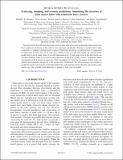Scattering, damping, and acoustic oscillations: Simulating the structure of dark matter halos with relativistic force carriers
Author(s)
Buckley, Matthew R.; Zavala, Jesus; Cyr-Racine, Francis-Yan; Sigurdson, Kris; Vogelsberger, Mark
DownloadPhysRevD.90.043524.pdf (6.003Mb)
PUBLISHER_POLICY
Publisher Policy
Article is made available in accordance with the publisher's policy and may be subject to US copyright law. Please refer to the publisher's site for terms of use.
Terms of use
Metadata
Show full item recordAbstract
We demonstrate that self-interacting dark matter models with interactions mediated by light particles can have significant deviations in the matter power spectrum and detailed structure of galactic halos when compared to a standard cold dark matter scenario. While these deviations can take the form of suppression of small-scale structure that are in some ways similar to that of warm dark matter, the self-interacting models have a much wider range of possible phenomenology. A long-range force in the dark matter can introduce multiple scales to the initial power spectrum, in the form of dark acoustic oscillations and an exponential cutoff in the power spectrum. Using simulations we show that the impact of these scales can remain observationally relevant up to the present day. Furthermore, the self-interaction can continue to modify the small-scale structure of the dark matter halos, reducing their central densities and creating a dark matter core. The resulting phenomenology is unique to these type of models.
Date issued
2014-08Department
Massachusetts Institute of Technology. Department of Physics; MIT Kavli Institute for Astrophysics and Space ResearchJournal
Physical Review D
Publisher
American Physical Society
Citation
Buckley, Matthew R., Jesus Zavala, Francis-Yan Cyr-Racine, Kris Sigurdson, and Mark Vogelsberger. "Scattering, damping, and acoustic oscillations: Simulating the structure of dark matter halos with relativistic force carriers." Phys. Rev. D 90, 043524 (August 2014). © 2014 American Physical Society
Version: Final published version
ISSN
1550-7998
1550-2368